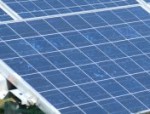While solar’s ascent in 2010 was stunning, it would play an even bigger role in our energy mix and have achieved grid parity across many more markets already if fossil fuel subsidies were removed.
Global manufacturing of solar PV materials continues to skyrocket, with new figures showing that last year saw a record-breaking 24,000 megawatts (MW) of crystalline silicon and thin-film solar panels produced around the world.
According to data compiled by GTM Research for the Earth Policy Institute, solar PV growth in 2010 doubled that of 2009, with annual solar cell production growing 100-fold since 2000, when just 277 megawatts of PV cells were produced.
But it’s not just solar makers breaking records. Installed capacity of solar PV also rose to 16,600 megawatts in 2010, bringing total global capacity to 40,000 megawatts – enough, the report says, to power 14 million European homes.
Crystalline silicon solar panels continue to dominate PV sales worldwide, taking the majority slice of the market at 80 percent. China remains, as it has for the past seven years, the biggest producer of silicon solar panels (11,000 megawatts of PV cells in 2010), followed by Taiwan (3,600 megawatts), Japan (2,200MW), Germany (2,000MW) and the USA (1,100MW).
But national PV production figures don’t necessarily translate to clean energy at home. Germany holds top spot in installed solar power with a current total of 17,200MW generating electricity for some 3.4 million homes, followed by Spain at 3,800MW.
Although the USA ramped up PV installations by 50 percent in 2010, Italy has claimed its spot as number four in the world solar rankings with a figure of 3,500MW. The report states that by the end of 2011, Italy will exceed its 2020 solar PV installation target of 8000MW and could realistically reach 30,000MW – enough solar energy to power half the county’s population.
China, the world’s largest carbon emitter, is taking steps to address slow growth in domestic solar PV growth. Total installed PV in China grew 140 percent to nearly 900MW in 2010, and with the implementation of a new national feed-in tariff for solar projects combined with the national Golden Sun program, which provides incentives for companies investing on solar installations, the report predicts capacity of solar PV in China to grow by 1000MW per year after 2012.
The report states that solar energy would currently be a cost effective and realistic alternative to fossil fuels if governments removed the heavy subsidies the fossil fuel sector enjoys.
“If the full cost of burning fossil fuels, including health effects and the costs of climate change, were incorporated into the price of electricity, PV would quickly be revealed as one of the least expensive sources of power.”












































